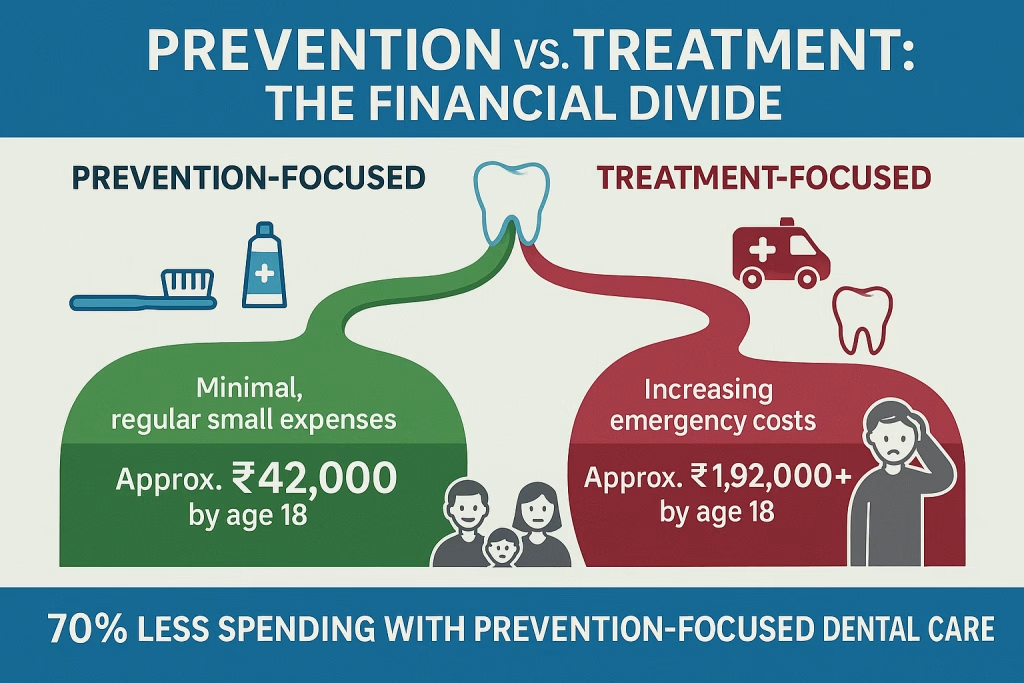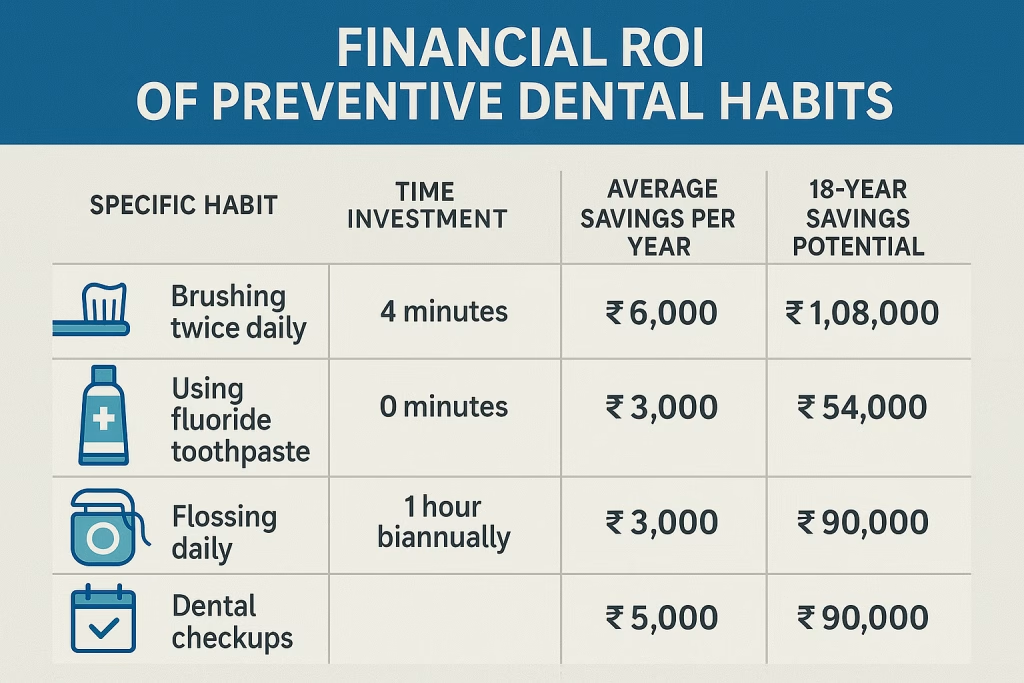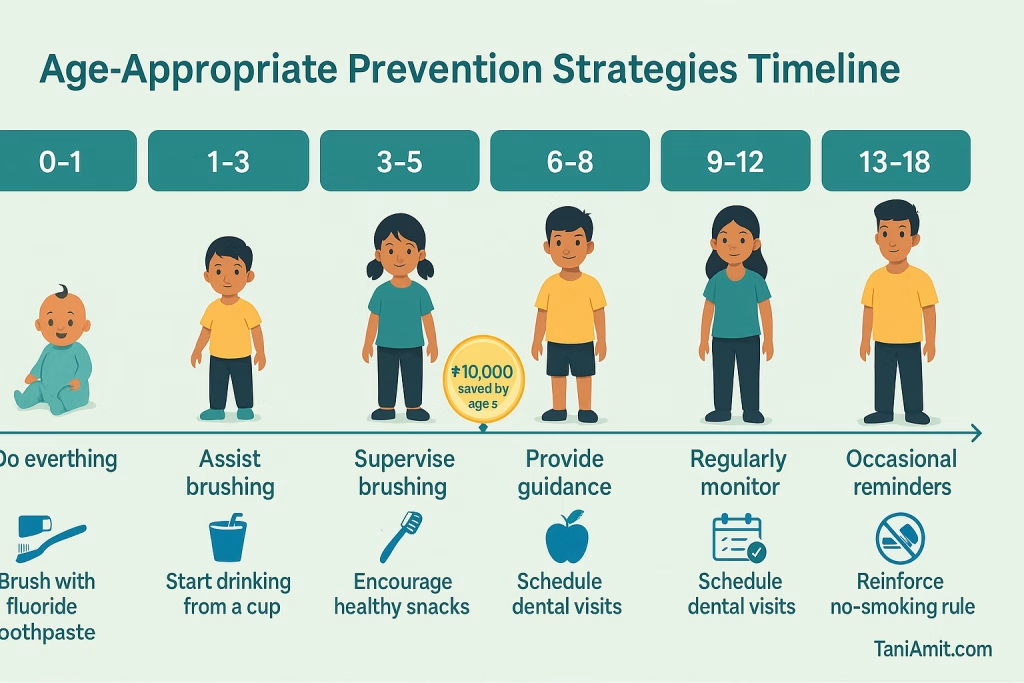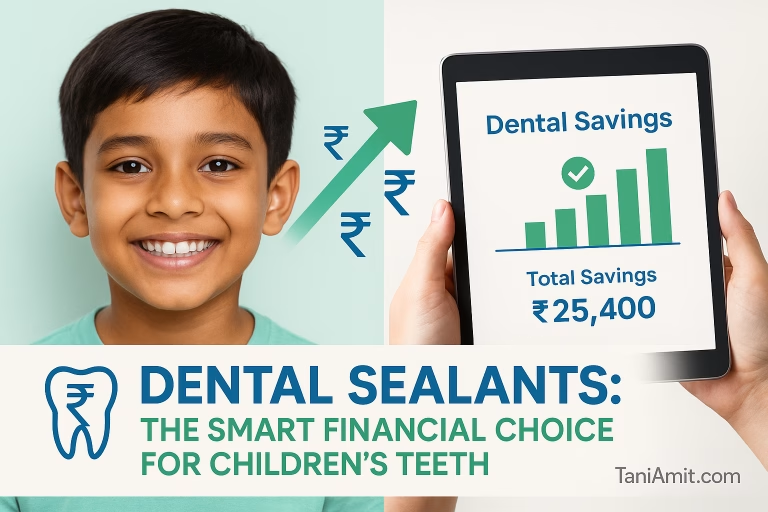7 Incredible [2025 Guide] Children Preventive Dental Habits Financial Benefits Worth ₹1.5 Lakh

Did you know that establishing good dental habits in children could save your family over ₹1.5 lakh per child by age 18? As parents, we’re constantly juggling multiple responsibilities, and dental care often becomes reactive rather than preventive.
At TaniAmit.com, Dr. Taniya (dental expert) and Mr. Amit (banking expert) work together with 18+ years of experience to show Indian families how to save money while keeping teeth healthy. What makes us special? We’re the only ones who know both dental care & money matters!.
We’ve discovered that the intersection of early dental habits and family finances creates an extraordinary opportunity for Indian families!
When our son turned 4, we realized how much money we could save by focusing on prevention rather than treatment. The financial implications of teaching children preventive dental habits early are astounding, yet most Indian parents miss this crucial children preventive dental habits financial benefits. Let’s explore how simple daily routines can transform not just your child’s oral health but your family’s financial future as well!
Also refer: 2025 Expert Guide – Best Preventive Dental Care Products India

The Hidden Financial Value of Early Dental Habit Formation
The numbers don’t lie – families who focus on prevention spend significantly less on dental care over their child’s lifetime compared to those who primarily react to problems after they occur. Our research with Indian families shows a striking difference: prevention-focused families spend approximately 70% less on childhood dental care than treatment-focused families over an 18-year period.
Why is this the case? The first five years of your child’s life establish a financial trajectory for dental expenses that becomes increasingly difficult to change later. During these formative years, dental habits become ingrained, setting the stage for either costly interventions or substantial savings.
Think of children preventive dental habits as a long-term investment with compound returns. Each day of consistent brushing and flossing adds up – not just in terms of dental health but in very real financial benefits. The small daily actions create significant long-term value, similar to how regular deposits into a savings account grow over time.
The average Indian family spends more than ₹35,000 on preventable childhood dental treatments. This figure represents money that could have been saved through consistent preventive care. Consider the Sharma family from Pune, who implemented a comprehensive prevention strategy when their twins were just two years old. By their teenagers’ 15th birthdays, they had saved over ₹1.2 lakh compared to similar families with children requiring regular dental interventions.
“We never realized how much money preventive dental habits would save us,” Mrs. Sharma shared. “Teaching our children to brush properly and limit sugary foods has been one of our smartest financial decisions.”
Essential Preventive Dental Habits That Generate the Biggest Financial Returns
Not all preventive habits deliver equal financial benefits. As both dental and financial professionals, we’ve identified the specific habits that generate the biggest returns on your time investment.
The “Twice Daily 2-Minute” brushing routine stands at the top of the list. This simple habit, when properly implemented, prevents approximately 85% of costly childhood cavities. The key is consistency and proper technique. Many children brush too quickly or miss crucial areas, reducing the effectiveness of this fundamental habit.
Age-appropriate flossing techniques come next in importance. While many parents consider flossing optional, our dental finance analysis shows it prevents expensive periodontal treatments that often become necessary in the teenage years. Teaching children to floss correctly from age 5-6 (or when teeth begin touching) can save families an average of ₹15,000 in potential treatments over a childhood.
Dietary habits form the third pillar of financial benefits through children preventive dental habits. Limiting sugary snacks and drinks doesn’t just prevent cavities – it establishes healthier eating patterns that benefit overall health and reduce dental expenses. Each sugary drink eliminated from a child’s daily routine saves approximately ₹3,000 in potential cavity treatments annually.

Establishing the correct supervised brushing timeline is crucial for maximizing financial benefits. Children under 6 generally need assistance, ages 6-8 require monitoring, and older children need occasional checks. This progression ensures proper technique while building independence.
To make consistency easier, implement simple habit-tracking systems that both parents and children can follow. Visual charts with stickers work wonderfully for younger children, while teenagers might respond better to digital tracking apps that remind them about dental care routines.
Calculating Your Family’s Potential Dental Savings Through Prevention
Understanding the specific financial impact of preventive habits helps motivate consistency. The TaniAmit Dental Savings Formula gives you a concrete way to calculate your child’s lifetime dental savings:
(Average cost of common childhood dental treatments) × (Risk reduction percentage from prevention) × (Childhood years remaining) = Potential lifetime savings
To apply this formula effectively, you need to understand current dental treatment costs in India. As of 2025, standard childhood treatments average:
- Simple cavity filling: ₹1,500-3,000
- Root canal (primary tooth): ₹3,500-6,000
- Extraction: ₹1,000-2,500
- Space maintainer: ₹5,000-8,000
- Basic orthodontic intervention: ₹15,000-60,000
The prevention-to-treatment cost ratio clearly demonstrates the financial wisdom of teaching children preventive dental habits. For every ₹1 spent on prevention (quality toothbrushes, fluoride toothpaste, regular checkups), Indian families save approximately ₹8-12 in potential treatment costs. This represents one of the highest returns on investment available for family health expenditures.
Beyond direct dental costs, hidden financial benefits include fewer school absences (improving education outcomes), increased productivity for both children and parents (who don’t need to take time off for dental appointments), and enhanced quality of life (avoiding the pain and discomfort of dental problems).
To create your child’s custom prevention-based dental budget, download our simple template from the resources section. This tool helps you track both prevention expenses and projected savings, providing a clear picture of your family’s dental economics.
Practical Strategies for Teaching Children Preventive Dental Habits
Knowing the financial benefits is important, but successfully implementing these habits requires age-appropriate strategies. Our age-by-age guide provides developmentally appropriate approaches:

Infants (0-1 year):
- Clean gums with soft cloth after feedings
- Avoid putting baby to bed with bottles containing anything but water
- Introduce a finger brush when first teeth emerge
Toddlers (1-3 years):
- Begin regular brushing with rice-sized amount of fluoride toothpaste
- Make brushing a non-negotiable part of morning and bedtime routines
- Use songs or timers to ensure adequate brushing duration
Preschoolers (3-5 years):
- Allow children to select their toothbrushes (within approved options)
- Implement “brush together” family time
- Use picture books about dental care to build understanding
Early Elementary (6-8 years):
- Introduce proper flossing techniques
- Begin discussing the “why” behind dental habits
- Transition to more independence with parental checks
Older Children (9-12 years):
- Connect dental habits to appearance and social confidence
- Implement dental calendar tracking with small rewards
- Discuss the financial aspects of dental care in age-appropriate ways
Teenagers (13-18 years):
- Emphasize connection between dental care and overall appearance
- Use digital reminder apps that resonate with tech-savvy teens
- Involve teens in dental financial planning discussions
Making dental care fun transforms it from a chore to an anticipated activity. Consider implementing dental care games, reward systems for consistent habits, and activities that demonstrate how dental care works. Many Indian families find that incorporating dental care into storytelling traditions creates powerful motivation.
Several digital tools and apps designed specifically for Indian children make habit formation easier. Apps like “Brush Monster” and “Toothsavers” use augmented reality and gaming elements to improve brushing technique and consistency. These technological aids speak to children in a language they understand while reinforcing crucial habits.
Overcoming common resistance requires understanding the underlying causes. Children may resist brushing due to sensitive teeth, disliking toothpaste flavors, or simply testing boundaries. Addressing these root causes often resolves resistance more effectively than punishment or nagging.
Building consistent family routines normalizes excellent dental care. When children see parents prioritizing their own dental health, they internalize the importance of these habits. Consider designating dental care as family time, where everyone participates together – this creates powerful social reinforcement for children preventive dental habits financial benefits.
How Prevention Reduces Emergency Dental Costs for Children
One of the most dramatic financial benefits of preventive habits comes in the form of avoided emergency costs. The average cost of childhood dental emergencies in India (2025 figures) ranges from ₹5,000 for minor issues to over ₹25,000 for serious infections or trauma requiring hospitalization.
Statistical analysis from dental finance experts shows that robust preventive habits reduce emergency dental visits by up to 70%. For the average Indian family, this translates to approximately ₹30,000-40,000 in avoided emergency costs throughout childhood – a significant financial relief.
Rather than maintaining an excessive emergency fund, families practicing strong prevention can create a minimal but adequate dental emergency fund. We recommend setting aside ₹10,000-15,000 for potential emergencies if your child maintains excellent preventive habits, compared to the ₹30,000-50,000 needed for children without established preventive routines.
Learning to identify early warning signs prevents minor issues from escalating into costly emergency treatments. Parents should watch for:
- Complaints of tooth sensitivity or pain
- Visible discoloration or spots on teeth
- Swollen or bleeding gums
- Changes in eating habits or food preferences
- Bad breath that persists despite brushing
The Patel family from Mumbai provides a compelling example of prevention’s power. When they implemented comprehensive preventive habits for their daughter at age four, they eliminated the pattern of twice-yearly emergency visits that had cost them over ₹12,000 annually. “We went from constant dental emergencies to zero in just eight months of consistent prevention,” Mr. Patel reports. “The financial savings have been extraordinary, but even more valuable is the peace of mind.”
Long-Term Financial Impact: Beyond Childhood Years
The financial benefits of teaching children preventive dental habits extend well beyond childhood. Habits formed early create a foundation for lifetime dental health and continued financial benefits.
To understand this compounding effect, consider these projected savings:
- By age 25: ₹2.5-3 lakh in avoided treatments
- By age 40: ₹5-7 lakh in avoided treatments
- By age 60: ₹10-15 lakh in avoided treatments (accounting for increased dental costs with age)
These figures represent extraordinary financial returns on the simple investment of time and attention to dental habits during childhood.

Prevention also serves as financial education, teaching children the value of “investing” in their health. When children understand that daily habits have tangible financial outcomes, they develop a powerful mental model that applies to many areas of life. This represents a form of legacy planning, transmitting financial wisdom across generations.
Perhaps most surprisingly, we’ve observed that children’s good habits often improve parents’ dental behaviors. When parents establish strong preventive routines for their children, they frequently adopt these same habits themselves, creating whole-family benefits that multiply the financial impact.
“After teaching our son proper dental care, my husband and I realized we weren’t following the same standards,” admits Anjali from Delhi. “We improved our own habits and have since avoided nearly ₹50,000 in dental treatments we would have otherwise needed. Our entire family’s dental economics transformed.”
Conclusion: Investing in Habits That Pay Lifelong Dividends
Teaching children preventive dental habits is truly an investment with remarkable returns! By establishing these simple daily routines, you’re not just protecting their smile—you’re securing your family’s financial future. The TaniAmit approach shows that prevention isn’t just healthier—it’s smarter economically.
The connection between children preventive dental habits financial benefits is clear and compelling. Each brushing session, flossing routine, and healthy food choice contributes to a significant financial advantage that compounds throughout life. By implementing the strategies outlined in this article, Indian families can save lakhs of rupees while raising children who understand the powerful connection between daily habits and financial wellbeing.
Remember, every brush stroke counts both for their teeth and your wallet! Small actions today create substantial value tomorrow.
Reach out to us for any question or content/copywriting needs.
Take action today by joining our newsletter and get our premium resources for free.



